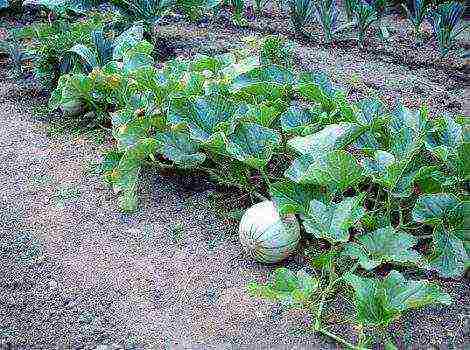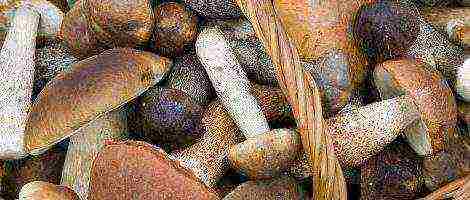Content [show]

The hydrogel is capable of absorbing and retaining moisture for a long time, which makes it very useful in the flower industry. How can the substance be used?
Hydrogel is a polymer compound that is actively used in agriculture, and recently florists and phytodesigners have also paid attention to it. Plants can be planted directly in the hydrogel, or you can mix the substance with soil for indoor flowers. The liquid absorbed by the hydrogel does not evaporate or flow onto the tray, and also does not lose nutrients.
Planting plants in a hydrogel
A plant in a hydrogel can become not just an interior decoration, but also an excellent gift, because it looks very original. The hydrogel is commercially available in various colors, so it can be used to create a very bright and beautiful composition. The cost of the substance is not very high, and its consumption is quite small, so one sachet will be enough for a long time.

Hydrogel granules
Tableware. Containers for planting plants should be chosen transparent so that the balls or pieces of hydrogel are clearly visible. As for the shape of the vessels, it can be absolutely any (when planting plants in a hydrogel, the possibility of damaging the roots is minimized). For small plants growing in rosettes, glass goblets can be chosen, and for larger specimens, round or cylindrical vases are suitable.
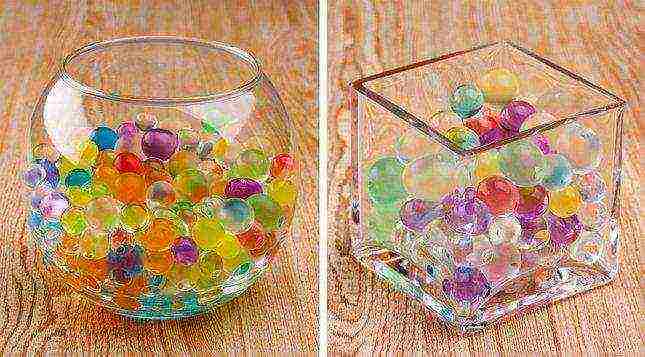
Glass containers with hydrogel
Hydrogel preparation... You need to fill in the hydrogel with clean water suitable for irrigation (settled, distilled). For 1 g of dry matter, about 300 ml of liquid can go. It is best to look at the required proportions on the packaging.
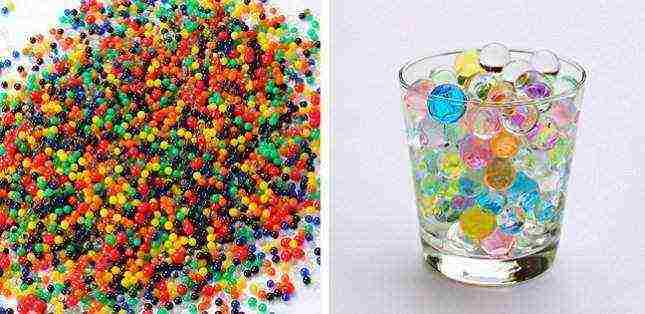
Hydrogel
What plants can be grown in a hydrogel? Grow well in polymer absorbent shefflera, chlorophytum, dracaena, tradescantia, syngonium, cordilina, scindapsus... Suitable for shaded corners of the apartment spathiphyllums, ficuses and sansevieria... Some growers grow flowering plants in hydrogel: Kalanchoe, Guzmania, Tilandsia and anthurium.
Do not plant flowers in the hydrogel that do not need frequent watering. For example, most succulents and epiphytes store moisture in leaves and roots, and being in a humid environment will cause them to rot.
Landing. Planting flowers in a hydrogel does not fundamentally differ from planting in ordinary soil. First, the roots of the plants must be rinsed well under running water so that no parts of the old soil remain on them. Next, the container for planting must be filled with a hydrogel, the plant should be placed in it and a little more substance added. That's all, nothing complicated.The only thing to watch out for is to keep the plant upright (this can be a problem as the hydrogel is very slippery).

Plant in hydrogel
Features of care. Watering a plant planted in a hydrogel should be 6 times less frequent than plants in soil. The substance itself will tell you about the need for watering, which will begin to settle a little - this means that a lot of moisture has begun to leave it.
Planting plants in soil with hydrogel
Planting indoor flowers in such a soil greatly facilitates their care, because such plants can be watered less often. In addition, the hydrogel helps plants adapt to new conditions faster after transplanting.
How to properly formulate a hydrogel substrate?
1. The first step is to mix the substance with a suitable substrate. For 1 liter of soil, only 2-3 g of hydrogel is required.
2. Then the granules should be mixed well with the earth.
3. Now the resulting mixture must be watered abundantly so that it is well saturated, and the hydrogel has absorbed the required amount of moisture. Now plants can be planted in such land.
The hydrogel in the substrate retains its qualities for 3-5 years, so it is enough to add it to the ground once during planting.
What plants can be grown in a hydrogel? For growing in a hydrogel substrate, moisture-loving plants are suitable, as well as species that are suitable for growing in hydroponics. So, you can plant in soil with polymer chlorophytum, ivy, codiaum, kalanchoe... Some growers even grow succulents like this, for example, fat woman or spurge... And beautifully flowering Saintpaulias, petunias, gloxinias, when planted in a substrate with a hydrogel, even begin to grow more intensively and bloom more abundantly.
Features of care. Caring for plants planted in the ground with the addition of hydrogel granules is practically no different from ordinary care. The only thing to remember is not to water the plants too often.
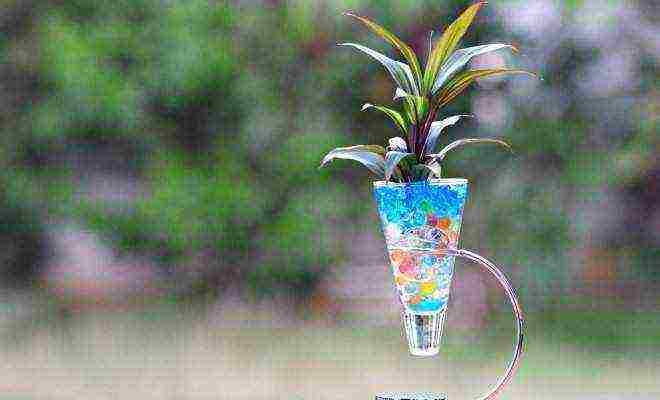
The hydrogel is capable of absorbing and retaining moisture for a long time, which makes it very useful in the flower industry. How can the substance be used?
Hydrogel is a polymer compound that is actively used in agriculture, and recently flower growers and phytodesigners have also paid attention to it. Plants can be planted directly in the hydrogel, or you can mix the substance with soil for indoor flowers. The liquid that the hydrogel absorbs does not evaporate or flow onto the tray, and also does not lose nutrients.
Planting plants in a hydrogel
A plant in a hydrogel can become not just an interior decoration, but also an excellent gift, because it looks very original. The hydrogel is commercially available in various colors, so it can be used to create a very bright and beautiful composition. The cost of the substance is not very high, and its consumption is quite small, so one sachet will be enough for a long time.

Hydrogel granules
Tableware. Containers for planting plants should be chosen transparent so that the balls or pieces of hydrogel are clearly visible. As for the shape of the vessels, it can be absolutely any (when planting plants in a hydrogel, the possibility of damaging the roots is minimized). For small plants growing in rosettes, glass goblets can be chosen, and for larger specimens, round or cylindrical vases are suitable.
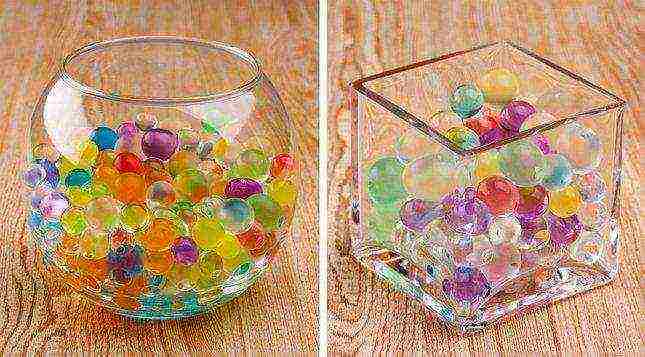
Glass containers with hydrogel
Hydrogel preparation... You need to fill in the hydrogel with clean water suitable for irrigation (settled, distilled). For 1 g of dry matter, about 300 ml of liquid can go away. It is best to look at the required proportions on the packaging.
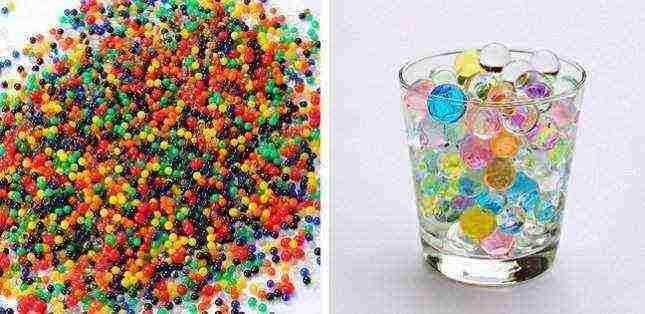
Hydrogel
What plants can be grown in a hydrogel? Grow well in polymer absorbent shefflera, chlorophytum, dracaena, tradescantia, syngonium, cordilina, scindapsus... Suitable for shaded corners of the apartment spathiphyllums, ficuses and sansevieria... Some growers grow flowering plants in hydrogel: Kalanchoe, Guzmania, Tilandsia and anthurium.
Do not plant flowers in the hydrogel that do not need frequent watering. For example, most succulents and epiphytes store moisture in leaves and roots, and being in a humid environment will cause them to rot.
Landing. Planting flowers in a hydrogel does not fundamentally differ from planting in ordinary soil. First, the roots of the plants must be rinsed well under running water so that no parts of the old soil remain on them. Next, the container for planting must be filled with a hydrogel, the plant should be placed in it and a little more substance added. That's all, nothing complicated. The only thing to watch out for is to keep the plant upright (this can be a problem as the hydrogel is very slippery).
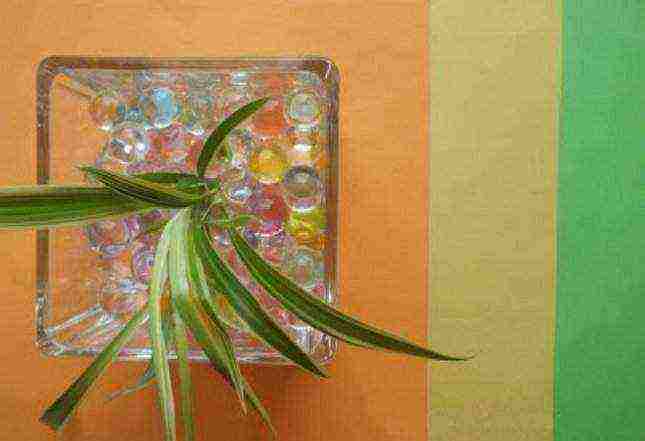
Plant in hydrogel
Features of care. Watering a plant planted in a hydrogel should be 6 times less frequent than plants in soil. The substance itself will tell you about the need for watering, which will begin to settle a little - this means that a lot of moisture has begun to leave it.
Planting plants in soil with hydrogel
Planting indoor flowers in such a soil greatly facilitates their care, because such plants can be watered less often. In addition, the hydrogel helps plants adapt to new conditions faster after transplanting.
How to properly formulate a hydrogel substrate?
1. The first step is to mix the substance with a suitable substrate. For 1 liter of soil, only 2-3 g of hydrogel is required.
2. Then the granules should be mixed well with the earth.
3. Now the resulting mixture must be watered abundantly so that it is well saturated, and the hydrogel has absorbed the required amount of moisture. Now plants can be planted in such land.
The hydrogel in the substrate retains its qualities for 3-5 years, so it is enough to add it to the ground once during planting.
What plants can be grown in a hydrogel? For growing in a hydrogel substrate, moisture-loving plants are suitable, as well as species that are suitable for growing in hydroponics. So, you can plant in soil with polymer chlorophytum, ivy, codiaum, kalanchoe... Some growers even grow succulents like this, for example, fat woman or spurge... And beautifully flowering Saintpaulias, petunias, gloxinias, when planted in a substrate with a hydrogel, even begin to grow more intensively and bloom more abundantly.
Features of care. Caring for plants planted in the ground with the addition of hydrogel granules is practically no different from ordinary care. The only thing to remember is not to water the plants too often.
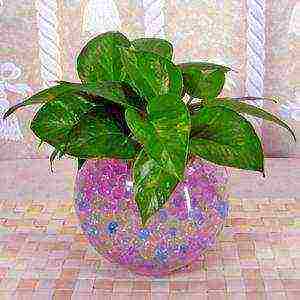 Flower lovers must have noticed beautiful bright balls in glasses or vases on the shelves of flower shops. In gardening, this know-how has appeared recently, but the tool immediately became popular with flower growers. Beautiful and bright balls are a hydrogel for plant care. What is this innovation, how to use it correctly and what should be considered when buying a hydrogel for plants?
Flower lovers must have noticed beautiful bright balls in glasses or vases on the shelves of flower shops. In gardening, this know-how has appeared recently, but the tool immediately became popular with flower growers. Beautiful and bright balls are a hydrogel for plant care. What is this innovation, how to use it correctly and what should be considered when buying a hydrogel for plants?
What is the hydrogel for?
Many flower lovers will be interested in learning in more detail what a hydrogel is, how to use it so as not to harm their favorite plants. Recently, the tool is often advertised and in great demand. This is not surprising, because the colorful granules look attractive, and they can be used for different purposes.
The hydrogel is in the form of granules, less often of a powder; in this form it is sold in bags. Beautiful multi-colored balls are made of granular polymer. The appearance of the balls is very attractive and many gardeners buy hydrogel as a decorative tool. A window sill with flowers looks not only green, but also elegant. But this approach is wrong, since the bright balls have a different purpose.
A hydrogel for indoor plants, absorbs moisture well... By sucking in water, the granules increase tenfold. One gram of hydrogel is capable of absorbing up to 200 grams of liquid. The gel balls give the accumulated moisture to the roots of indoor plants.
The flower hydrogel was designed to keep plants hydrated in between infrequent waterings. The swollen granules mix with the soil in which the flowers grow. On average, plants have enough moisture for 2-3 weeks. The roots grow into granules and absorb water. Much depends on the root system of flowers and its development. The granules continue to remain in the soil and after the next watering they are again saturated with moisture.
Due to this property of the hydrogel, plant roots will not rot from excess moisture. If you water indoor flowers with impure water, and with fertilizers, then the granules will be filled with this composition and bring double benefits to the plants. There are two types of hydrogelsintended for flowers.
- Soft - it practically has no color, due to its softness, the roots of plants freely penetrate through it and feed on moisture. It is great for those who cannot water the flowers often, and for germinating seeds and rooting cuttings.
- Dense (aqua soil) - can have different shapes in the form of balls, cubes, pyramids. It belongs to the decorative types of polymer, used for germinating seeds, It is convenient to use it instead of water in vases with bouquets of flowers.
Hydrogel: instructions for use
 Hydrogel granules come in a variety of colors and sizes, and are sold as such. Package may vary in weight... Typically, small granules are used to germinate seeds, while larger granules are used to add to the soil. The color of the substance does not affect its properties.
Hydrogel granules come in a variety of colors and sizes, and are sold as such. Package may vary in weight... Typically, small granules are used to germinate seeds, while larger granules are used to add to the soil. The color of the substance does not affect its properties.
Before using the gel, it is soaked in water, after which it absorbs moisture and significantly increases in size. It is believed that only 2 tablespoons of granules are enough for a 3-liter volume. After the granules are filled with water, they can be thrown into a colander and the remaining water drained.
Unused pellets can be stored perfectly in the refrigerator in an airtight container. When stored at room temperature, they shrink and crystallize.
In order to germinate seeds, the hydrogel balls must also be saturated with water and preferably with fertilizers. In this state, it will do more good. The pellets themselves do not contain the nutrients necessary for the plants, so water-soluble fertilizers will promote good growth and seed germ development.
Very often, gardeners use the substance to germinate seeds in several convenient ways. Much depends on the size of the seeds. Initially, the hydrogel was invented for use in agriculture, but as time has shown, it has become more in demand among flower growers.
The seeds can be sown in pure gel with water. After being saturated with moisture, they swell greatly, after which they can be crushed to the desired state in a convenient way:
- rub through a sieve;
- grind with a blender.
The prepared mass is laid out in a container with a layer of 3 cm and seeds are spread on top. Very large granules can be cut in half and spread the seeds on top by gently pressing with a toothpick. If the seeds are buried too deep, they will not have access to air. The entire seed is covered with foil. It needs to be removed periodically to ventilate the seeds.
Very often, gardeners use hydrogel to grow seedlings, in the ratio 3-4 parts potting mix and 1 part granules... The prepared mixture is filled in containers for growing seedlings and a thin layer of pure crushed hydrogel is placed on top. Seeds are placed in the top layer of the gel, after which they are sprayed with water and covered with a film.
You can germinate seeds in a pure gel, but in the cotyledonous leaf phase, the seedlings must be transplanted into the ground.It is advisable to transplant with a piece of gel so as not to damage the root.
Plant hydrogel application
 The product is often used to grow indoor flowers and plants in the garden. It is usually added when planting in a hole or in a potting soil. Due to its ability to retain moisture, the hydrogel is very convenient for those who do not have the opportunity to frequently water the plants.
The product is often used to grow indoor flowers and plants in the garden. It is usually added when planting in a hole or in a potting soil. Due to its ability to retain moisture, the hydrogel is very convenient for those who do not have the opportunity to frequently water the plants.
The gel is very convenient to use, it can be apply dry and soaked... The dry matter after watering will immediately absorb excess moisture and then give it to the plants. Experts recommend using the swollen gel for potted plants, and adding it dry in the garden. The proportion will depend on many factors:
- soil condition;
- planting conditions;
- frequency of watering.
For a long time, the hydrogel will absorb moisture and then give it to the plants. After the expiration date, it decomposes into ammonium, water and carbon dioxide, and nothing else is in it.
Hydrogel and aqua primer - what's the difference?
 At the peak of its popularity, many unscrupulous manufacturers of this product began to produce a completely different product. It has nothing to do with the hydrogel. A colorful alternative called "aqua primer" has an attractive appearance and is in high demand. The tool is available in different forms, which performs only a decorative function... If used incorrectly as part of a potting mix, it will only harm the root flower system.
At the peak of its popularity, many unscrupulous manufacturers of this product began to produce a completely different product. It has nothing to do with the hydrogel. A colorful alternative called "aqua primer" has an attractive appearance and is in high demand. The tool is available in different forms, which performs only a decorative function... If used incorrectly as part of a potting mix, it will only harm the root flower system.
The sensational one also often misrepresents information, for example, that aqua soil can be used in its pure form for germinating seeds. Buyers confuse it with a hydrogel and only harm their flowers and seeds. For this reason, many negative reviews about the hydrogel began to appear. Many simply confuse it with aqua soil, use it incorrectly, so the end result is disastrous.
When buying an aqua primer or hydrogel, you need to consider for which types of plants the products will be used. They are suitable for some plants, but there are types, showing negative reactions... It is best to use both products in a potting mix to keep the flowers in their familiar environment. Hydrogel or aqua soil in its pure form does not have nutrients, therefore it cannot create the necessary conditions for the active development and growth of flowers.
Florists who want to have on their windowsill not just flowers in pots, but real works of interior art, use a hydrogel for plants instead of soil. But many people are not familiar with this decorative and useful material. A hydrogel is a small ball made from a polymer material. They have a high absorption capacity, that is, they absorb water well.
In this case, the granules of the substance increase in size. For high decorative value, they are produced in a wide variety of colors. This material is excellent for replacing soil and has a number of advantages.
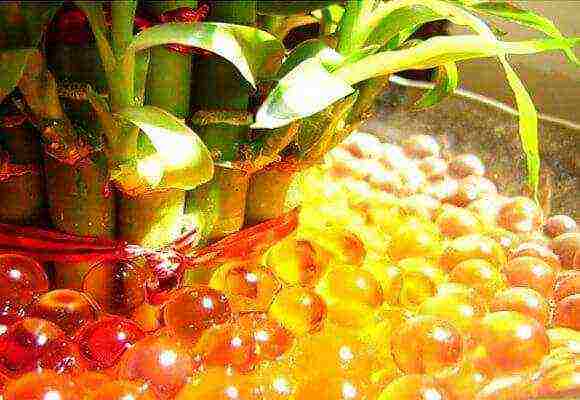
Hydrogel benefits
- The granules are absolutely safe, non-toxic. At the same time, the use of hydrogel instead of soil helps to prevent the appearance of midges that breed in the soil. Hydrogel for plants is an absolutely sterile environment in which bacteria, insect larvae and other microorganisms cannot live. When the substance is used together with the soil, after its expiration date, the granules simply decompose into carbon dioxide, water and ammonium. These substances are part of the soil. With this combined use, the balls will last about 5 years.
- Hydrogel granules have a decorative and aesthetic appearance. Placing the granules in a transparent pot, an amazing composition will flaunt on the windowsill. At the same time, the flowers in the hydrogel grow very well.
- For normal soil moisture, a flower hydrogel is a very useful invention. By soaking it with water and mixing it with the soil, you can avoid drying out or waterlogging of the soil. Then the plant will receive moisture as needed. And if you saturate the balls with liquid fertilizers and spread them on the bottom of the pot, then the need for fertilizing will disappear, since the plant will receive fertilizers dosed, for a long period.
- Using this development will significantly save time on watering plants. Watering the hydrogel for indoor plants, mixed with soil, the granules will be saturated with moisture and gradually release it. In this case, the need for daily watering disappears, and you can water the plants once a week or two.
- Saving money on fertilizers. When using liquid fertilizers, most of them drain into the pan, and when using hydrogel granules, all fertilizers are absorbed into them and are evenly consumed.
The advantages of this tool are obvious, so it is worth using this material. Even after it has lost its aesthetic appearance, you should not throw it away. The decomposition time of the granules is five years. Therefore, the pellets can simply be buried in plant pots or garden beds.
Varieties of hydrogel
In addition to color differences, the hydrogel is divided into two types - dense and soft.
- Dense, it is called aqua soil. These are balls or pyramids with different shades, they are used as a decorative material for growing flowers. Such material is mainly used for rooting cuttings, plants grow well in aqua soil, but periodically they need fertilizing with mineral fertilizers.
- Soft. Such a hydrogel has no color, and its main purpose is for growing seedlings, introducing them into the soil and germinating seeds. The structure of this product allows the roots of plants to penetrate inside and receive nutrition and moisture in this way.
But in order for the hydrogel for indoor plants to serve not only for a long time, but also correctly, it must be used according to the instructions.
Application rules
For granules to be beneficial to plants, you need to use it correctly.
- Soaking the hydrogel. If the balls are multi-colored, then the soaking dishes should be separate for each color. The balls from the bag are poured into a container and filled with water. The ratio of granules to water should be 10 grams to 2 liters. If necessary, dissolve fertilizers in water, it is better that they do not have color.
- After soaking, the balls are left to swell for 12 hours, after which they can be used. Each pellet should then grow to 1.5 centimeters.
- The indoor plant hydrogel is placed in a pot. After the granules have swollen, you can start mixing the colors.
- Next, you need to prepare the plant for planting in the hydrogel. For this, the roots are washed with running water. If it is necessary to root the stalk, then it is simply buried in the balls, and it will start up the roots there.
- As the granules dry, they are watered again. If the balls were used to put bouquets in them, then after drying, they can be put back in the bag and used again.
Aqua soil is not only suitable for growing plants, it can be used for cut bouquets and garden plants. In addition, the hydrogel is perfect for moisture-loving plants.

Today I will tell you about hydrogel for indoor plants and the features of its use. While still a student, and working on my graduate work, I conducted an experiment on the use of hydrogel as a component of potting soil for indoor plants.
Hydrogel Is a polymeric compound with an amazing ability to absorb, retain and release water to plants. It is absolutely non-toxic and completely safe for plants. The main sphere of its use is agriculture, but not so long ago, hydrogel began to be used in indoor floriculture and phytodesign.
It is very easy to create an original gift or just a bright decoration. Now hydrogel for indoor plants and phytodesign is available in various colors. The greatest effect is provided by the use of several shades - here it is already a matter of imagination (it should be noted that the consumption of hydrogel for planting one plant is small, and the price for it is acceptable).
The container for planting is chosen transparent, made of glass or plastic (with the exception of matte, patterned or cut) The shape of the container can be absolutely any and even contrary to the rules for selecting a pot, since the hydrogel is more plastic, easily removed, and there is no danger of injuring the roots when transplant. For small, rosette plants, glasses with a low stem are preferred, for larger ones, glass vases, high cylindrical or low round.
Hydrogel preparation
The hydrogel is poured with clean (filtered, settled or distilled water) at the rate of 200-300 ml per 1 g of dry matter. Complete swelling lasts about two hours.
Houseplant selection
Indoor plants that require rare watering (succulents, some epiphytes), with dense leathery leaves or storing water in tubers and roots are not suitable for growing in hydrogel.
Dracaena, cordilins, shefflers, codiaums, unpretentious chlorophytums, tradescantia, syngoniums, scindapsus, cyperus, ivy adapt well in hydrogel.
Spathiphyllum, arrowroot, aglaonema, sensevieria, and ficus are suitable for shaded or lacking sufficient lighting places, you can try to grow flowering anthuriums, Kalanchoe, Tilandsia, Guzmania and others on hydrogel.
Planting indoor plants in a hydrogel
It does not fundamentally differ from planting in the ground, fixing the plant in an upright position can become a possible problem. Before planting, the roots are thoroughly washed from the soil and carefully laid out on the surface of the hydrogel and then covered with the hydrogel to the desired level.
Caring for indoor plants in a hydroget
Over time, the roots grow into granules, and the plant receives water without interruption.Watering is needed about 5-6 times less often and in a smaller volume, a sign for watering is the settling of the hydrogel. The plant is also fed less often, it is better to limit yourself to mineral fertilizers.
Replacing the hydrogel
Typically, the service life of a hydrogel is about 5 years. A sign for replacement is the destruction of granules, the formation of a shapeless mass, and less water absorption.
Well, this is all in theory, quite simple and understandable. And now a little of my experience of growing plants in a pure hydrogel.
I tried to grow a very unpretentious Tradescantia in a hydrogel. I renewed the old plant and planted several cuttings not in the soil but in the hydrogel. Despite the well-developed roots, the plant grew with difficulty, the shoots stretched out, as if they did not have enough light, although the same Tradescantia, but felt much better in the soil. The leaves became pale, dull, thin, to the touch like rags.
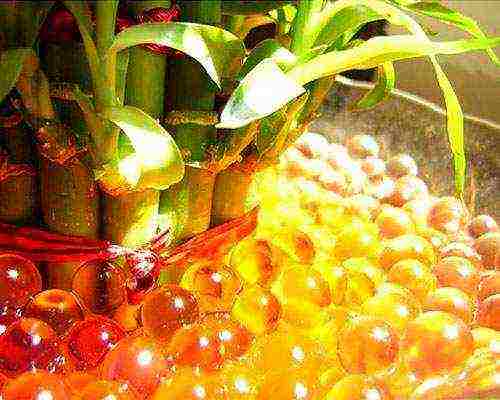
Much better in fuchsia hydrogel. It turned out that several cuttings had to be urgently planted, but not where. In order not to disappear, I put it in a vase with a hydrogel. Of course, it grew very slowly, but outwardly it looked very healthy and even picked up the buds, but then dropped it. Fuchsias are extremely sensitive during budding, and they react to everything by immediately dropping buds and flowers.
Recently, I decided to try again to grow a low-maintenance plant in a pure hydrogel. Chlorophytum just required a transplant. The first hydrogel I used was TM Agricola. The hydrogel consisted of irregularly shaped granules, no more than a centimeter in height and width.
Nowadays, hydrogel comes in the form of balls, cubes, etc. I bought a colored gibrogel, which was shaped like parallelepipeds, cubes, etc. I was very surprised at the size. Some crystals, after swelling, reached the size of a walnut.
Even small in size chlorophytum was not easy to fix, in my opinion, the granules were too large.
It is also worth noting that the water evaporated catastrophically quickly, a couple of days and the hydrogel settled on almost half of the vase. The roots of the plant were bare, and the chlorophytum's appearance became more and more dejected every day.
Now I do not grow plants in pure hydrogel, but use g
idrogel as a soil component,
but such huge granules are completely unsuitable. And if the moisture evaporates so quickly, then there is no point in it at all.
As a result, I will say that the hydrogel is very decorative and with the help of it you can single out any plant as a tapeworm and give the room a special zest. But you will have to try both by mistakes and by trial to look for such a plant.
The hydrogel is characterized by the fact that it can absorb moisture and retain it for a long time, due to which it is often used in indoor floriculture and when growing seedlings. Previously, this polymer compound was widely used in the agricultural industry, but now phytodesigners and flower growers have turned to it. Tellingly, plants can be grown both directly in the hydrogel and in soil mixed with this substance. The moisture that is absorbed by the hydrogel does not flow out onto the tray and does not evaporate; moreover, it does not lose its original beneficial properties. So, today you will learn everything about hydrogel for plants - application, features, pros and cons. The article will also provide step-by-step instructions for using the polymer compound.

Plant hydrogel - application
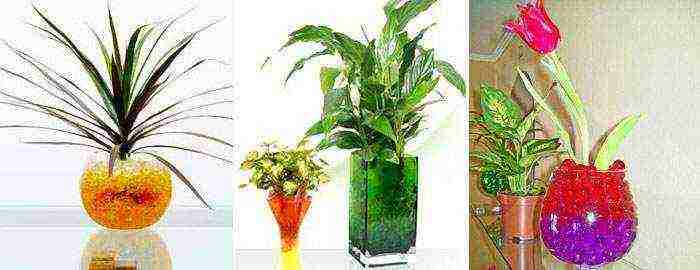
Using a hydrogel
Features of the use of material in crop production
A hydrogel is a polymer that makes great seedlings grow. Tellingly, when plants develop, they receive all the nutrients they need. First of all, the hydrogel is widely used to obtain seedlings.
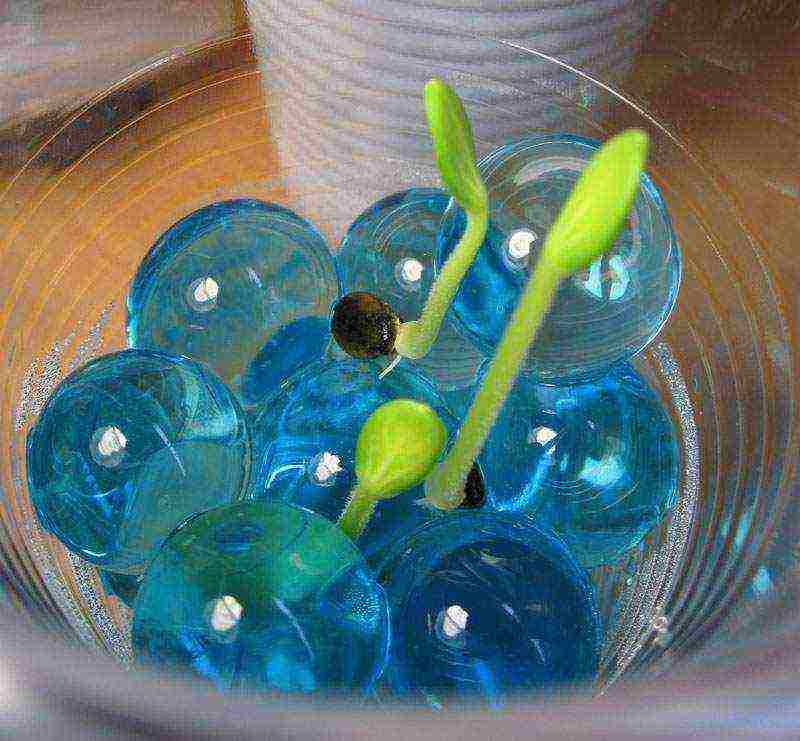
Hydrogel Balls
To get high-quality seedlings, the gardener has to face a number of difficulties.So that the seedlings turn out to be healthy and strong, you need not only good lighting and a well-prepared soil mixture, but also competent watering. Moisture is very useful for young seedlings, but in excess it can lead to decay of the roots, which, in turn, will cause the subsequent death of plants. To avoid all these troubles, you can use a hydrogel, which has unique properties - it absorbs moisture and retains it for the full growth of the grown crops.

Miracle crystals or hydrogel
Note! The hydrogel is used as a planting substrate (a kind of container with water) or as a special additive that retains moisture for the prepared soil mixture.
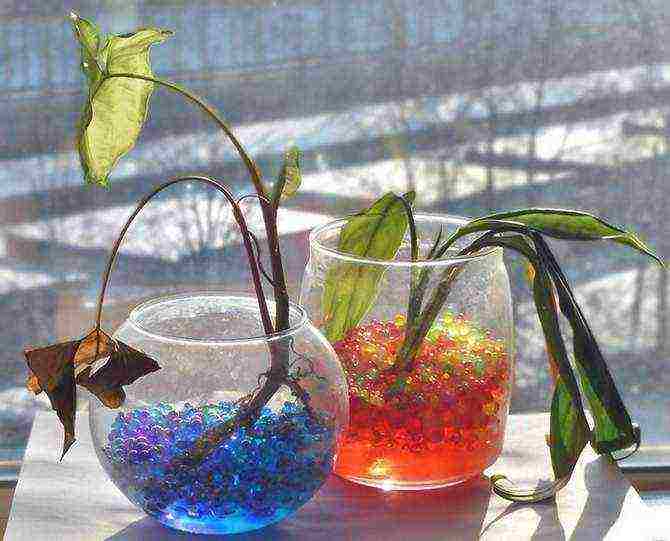
How is the hydrogel used?
The novelty, which appeared on the domestic market relatively recently, has already managed to acquire numerous admirers. If you start using it to grow indoor flowers or seedlings, you will no longer worry about watering and feeding young seedlings. This is explained by the fact that polymer granules absorb not only water, but also fertilizers in liquid form, due to which food is supplied as needed. It turns out that hydrogel is the ideal material for minimizing plant care, as well as reducing stress during traumatic soil transplantation.
The material is sold in the form of small beads like beads. If you add water to these balls, they swell, after which the polymer is ready for further use.
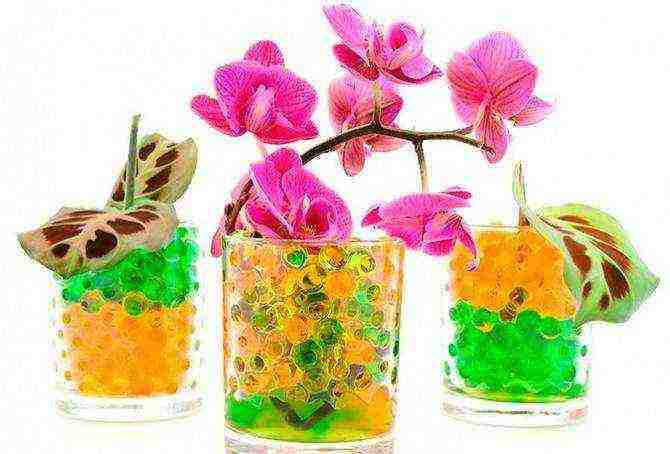
Indoor plant hydrogel
Advantages and Disadvantages of Using a Hydrogel
Despite the effectiveness and certain popularity, the described polymer granules have not yet found mass distribution. First of all, this is due to their recent appearance on the domestic market and the fact that most of the buyers do not know about the advantages of the material. And so that you don't have any doubts, let's get acquainted with the pros and cons of using a hydrogel.
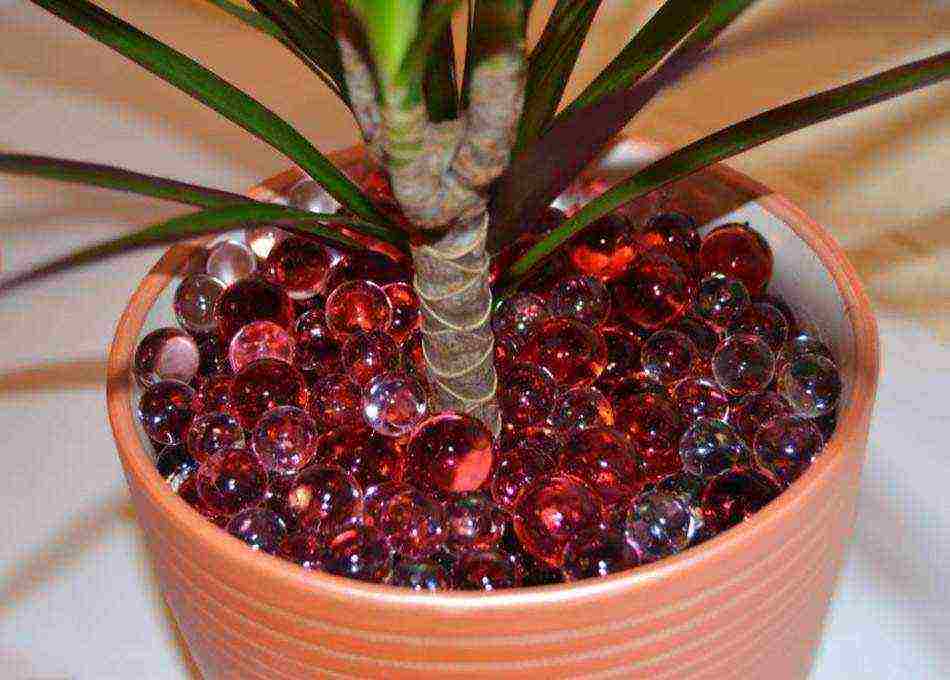
Plant hydrogel
As for the benefits, these include:
- increased moisture absorption (granules absorb 300 times their own weight), which allows maintaining the substrate moisture level required for plants for a long time;
- economy (to get 1 liter of base, only 1-1.6 g of dry granules are enough);
- earlier seed growth when compared with traditional cultivation;
- preservation of all trace elements present in the substrate (they are not washed out);
- high-quality aeration of seeds and roots.
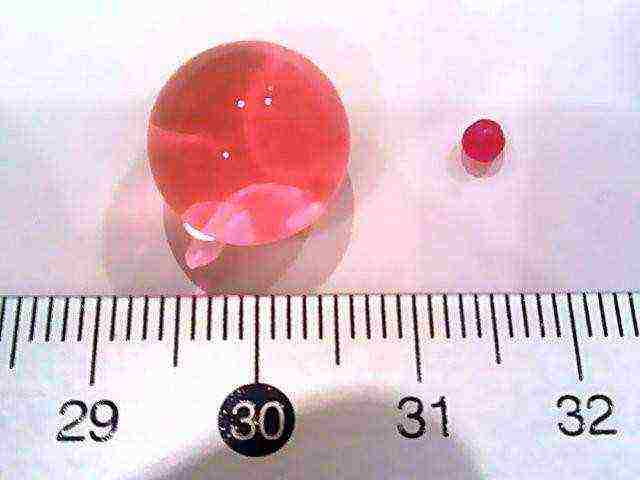
Dry and swollen granules of material
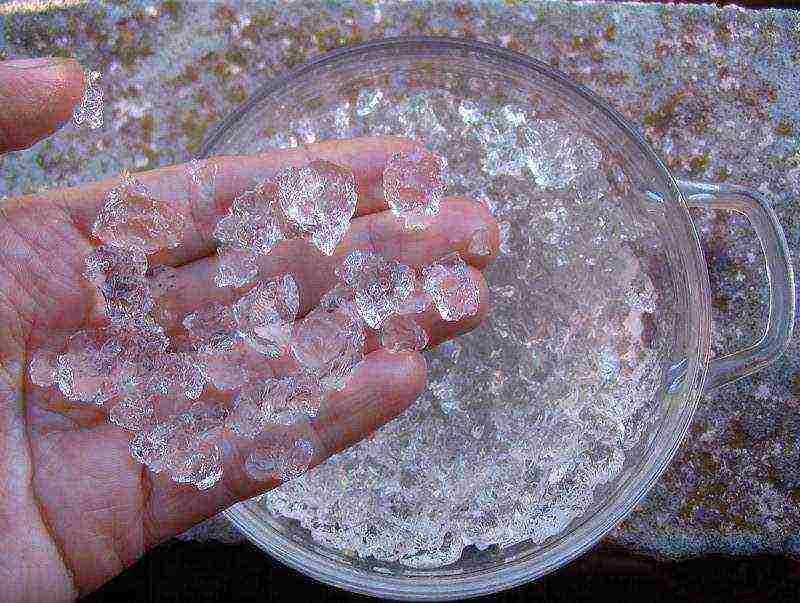
The hydrogel has absorbed water
However, there are disadvantages that you also need to know about before buying a hydrogel.
- You cannot grow crops in a hydrogel that have leathery seeds (such as sweet peas). In addition, when adding seed to a hydrogel, you must take into account the individual characteristics of a particular crop.
- It is also necessary to maintain the required temperature of the surface where the plants with the hydrogel are located - this will prevent hypothermia of the seedlings.
- Finally, the granules should not be reused, even if the manufacturers claim otherwise. The fact is that the already used hydrogel loses its absorbing properties, in addition, it becomes dark and wrinkles. Finally, bacteria can easily develop on the pellets after exposure to air. Therefore, the only thing this material will do is to use it in the form of a moisture-retaining additive for a soil mixture.
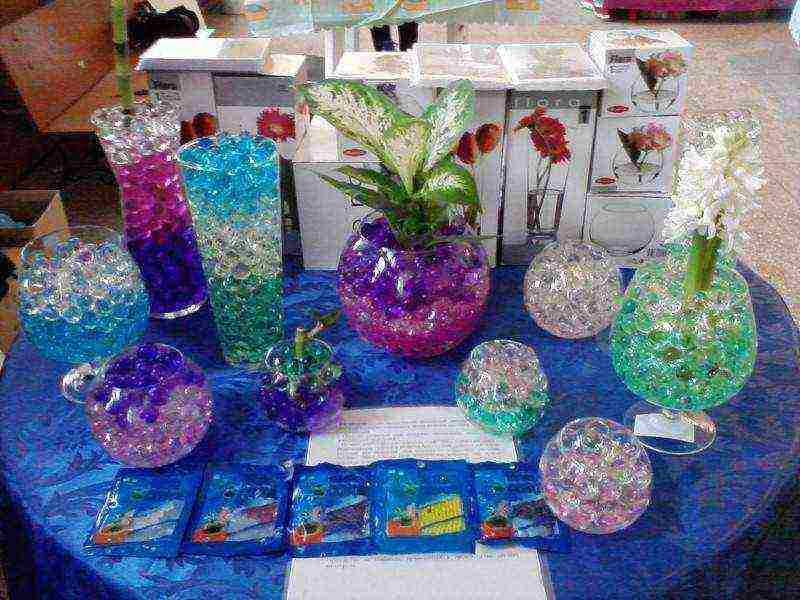
Indoor flowers in hydrogel
Note! Thanks to all the advantages and disadvantages of the material listed above, you can objectively assess your own capabilities and the likelihood of obtaining healthy plants.

Hydrogel
The main ways to use the hydrogel
There are several ways to use polymer granules at once, let's take a closer look at each of them.
Table. Methods of using the hydrogel.
 Method # 1 |
The seeds are placed in pre-prepared material. First, the granules are soaked, then crushed with a blender or grind through a sieve - as a result, a homogeneous mixture should be obtained. A 3 cm thick layer of hydrogel is placed in the pot, and seeds are placed on top of it, pressing a little. Excessive deepening of the seed is undesirable, because it can remain without oxygen, and this will negatively affect the quality of seedlings. After planting, the pots are covered with foil to ensure the desired microclimate. The cover can be removed daily to ventilate crops and remove condensation. |
 Method number 2 |
The hydrogel is also used as a moisture-absorbing additive in the soil mixture, which also gives excellent results. Here dry granules are mixed with the substrate (1: 3 or 1: 4), and the resulting mass is poured into a container. |
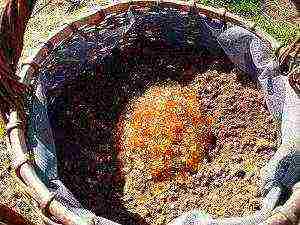 Method number 3 |
The last option is to use a hydrogel when planting in open soil. The roots are dipped into the swollen mass, and the seedlings are placed in the holes. Thanks to this, stress is reduced, and the plants are provided with moisture for the first time. |

In a mixture of hydrogel and earth, it is very convenient to grow plant cuttings, germinate seeds. Prepare such a mixture in the same way as a mixture for indoor plants.
Note! Hydrogel is an environmentally friendly material that stimulates the growth of crops and has a positive effect on the quality of the soil.
Video - How to germinate seeds with hydrogel
Features of growing in a hydrogel
Today, the hydrogel is sold in different colors, so the plant in it may well turn into a decoration, a beautiful and original composition. The material is not very expensive, and if we consider that its consumption is insignificant, then we can assume that the bag will last for a fairly long time.
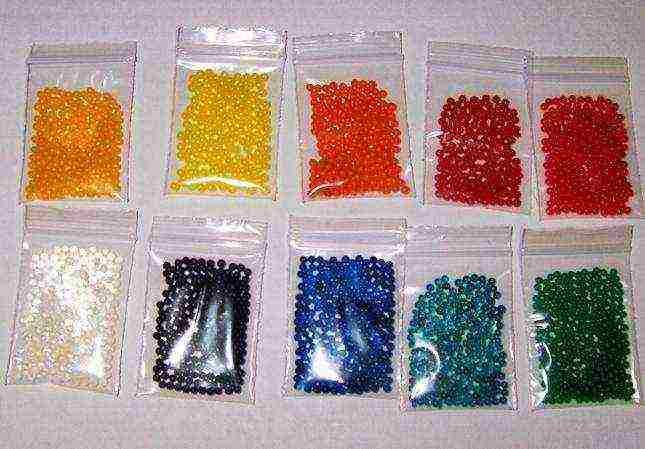
Hydrogel granules
Capacities... They must be transparent so that the granules of the material are clearly visible. The shape of the dishes does not matter at all, because when planting plants, the risk of damage to the roots is minimal. If the culture is small and grows with rosettes, then you can take a glass goblet for it, and if the plant is larger, then a vase will do.
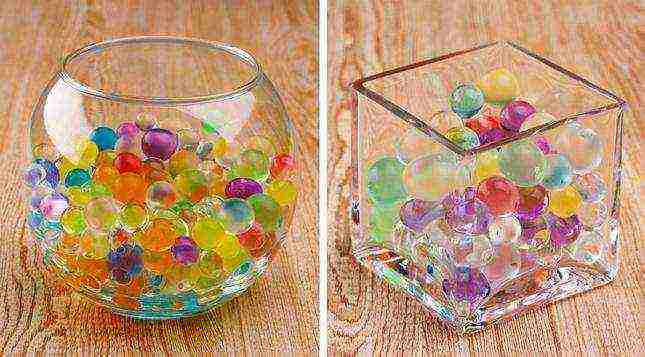
Glass containers with hydrogel
How to prepare a hydrogel... It is filled with purified distilled / settled water (about 300 ml per 1 g of material). More precise proportions should be indicated by the manufacturer on the packaging.
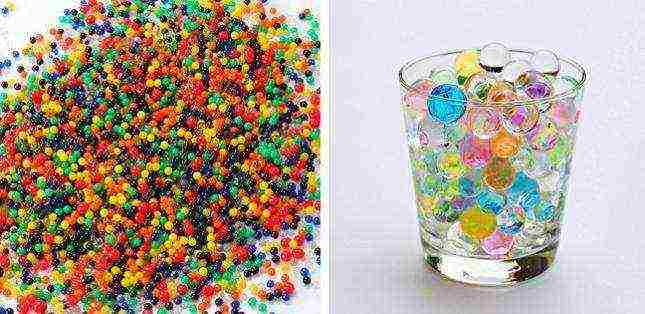
Hydrogel
Note! Do not grow plants in this way that need frequent watering. For example, epiphytes and succulents for the most part store moisture in the root system and leaves, and therefore staying in a humid environment can cause decay.
Landing features... The procedure is not much different from planting in ordinary soil. The container is filled with swollen granules, then a plant with pre-washed roots is placed there. If seeds are planted for seedlings, then the hydrogel after swelling must be crushed, as mentioned earlier. In a word, everything is quite simple. It is only necessary that the plants be in a strictly vertical position (and this can be difficult, since the material is very slippery).
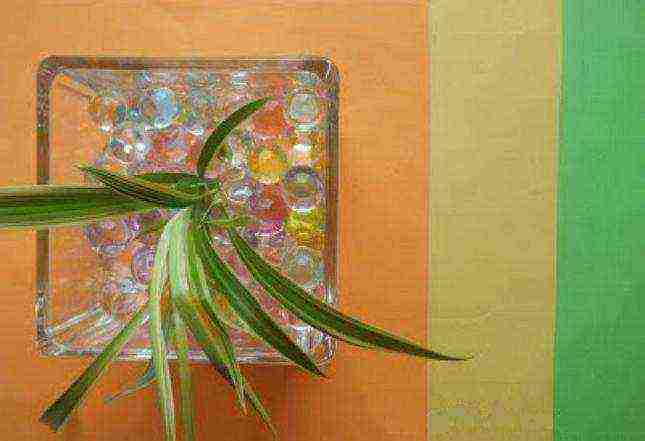
Plant in hydrogel
How to care... Watering should be done six times less often than with traditional cultivation. The fact that the plants need to be watered can be understood by the slightly settled hydrogel (evidence of the departure of a large amount of moisture).
How to plant a plant in soil with a hydrogel - step by step instructions
If you plant an indoor flower in such soil, then it will greatly facilitate caring for it. Moreover, the substance will help the flower quickly get used to new conditions.
Step one... First, mix the hydrogel with the prepared soil mixture.Approximate proportions are 2-3 grams of substance per 1 liter of soil.
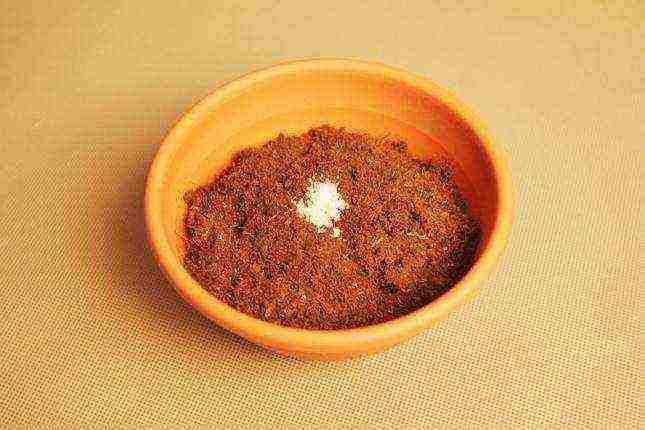
Hydrogel is added to the soil
Step two... After that, thoroughly mix the granules with the soil.
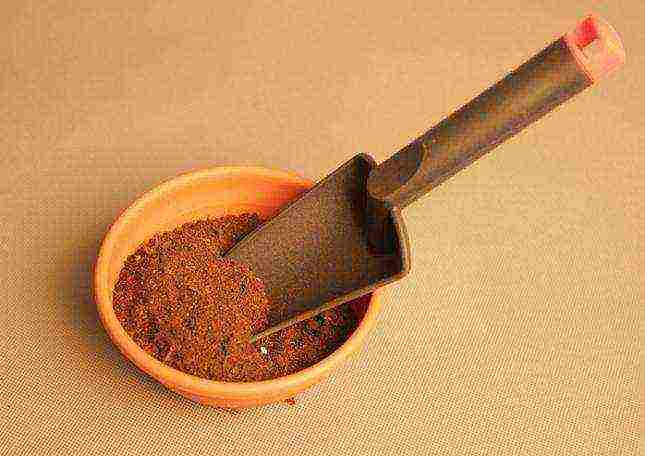
The granules are mixed with the ground
Step three... Pour the resulting mixture well so that it is saturated and the substance absorbed enough liquid. After that, you can proceed directly to planting plants.

Watering the mixture
Note! Polymer granules do not lose their original qualities for 3-6 years, which means that they can be applied only once directly during planting.
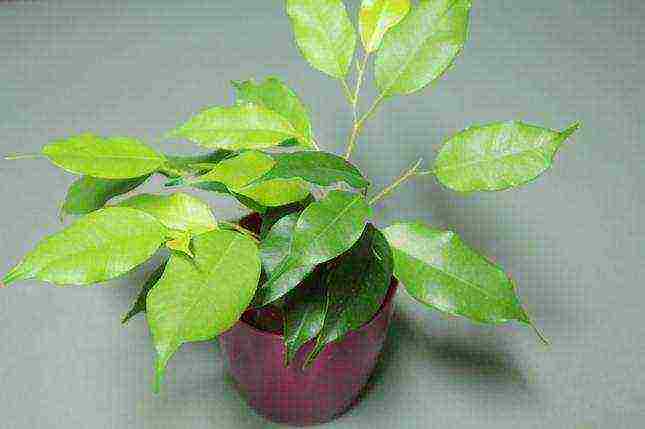
Plant grown in hydrogel
What cultures are suitable for this?
If we talk about a mixture of substrate and hydrogel, then moisture-loving crops are more suitable for this, as well as those plants that are suitable for hydroponic cultivation. Among indoor plants in soil with polymer, chlorophytum, euphorbia, ivy, bastard, Kalanchoe and others feel great. And beautiful petunias or saintpaulias after planting in such a substrate will develop faster and bloom better.
As for the care of crops planted in soil with a hydrogel, it is almost the same as in conventional cultivation. The only exception is watering - in this case, it should not be too frequent.
How to germinate greens with a hydrogel
According to doctors, daily use of greens helps to maintain health and youth for many years. And it is quite obvious that freshly picked greens are the most useful. In the summer it is grown in the beds, but in the winter you can arrange a small "vegetable garden" on the windowsill.
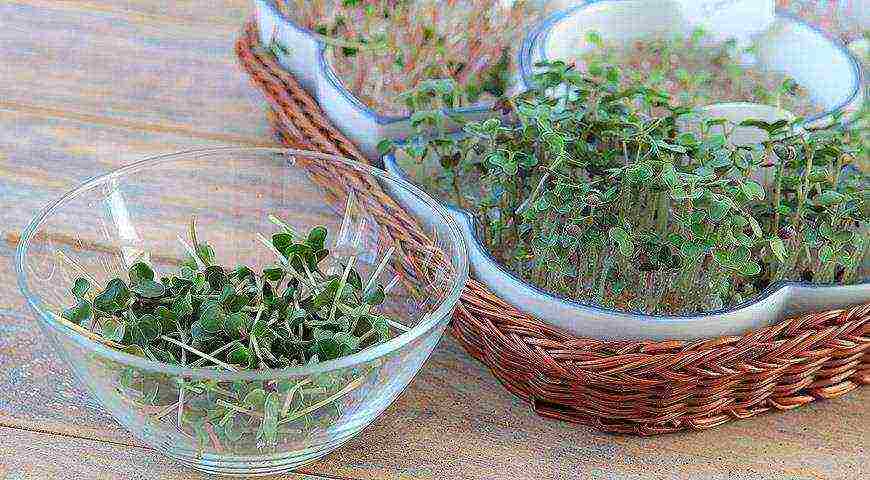
Germinating greens in a hydrogel
Before getting started, prepare:
- seed material;
- hydrogel;
- sowing containers.
After preparing everything necessary, proceed in accordance with the instructions. For the convenience of site visitors, it is shown in the form of a table.
Table. Do-it-yourself greens in a hydrogel.
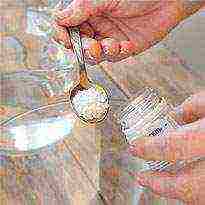 Step one |
To get started, take the hydrogel balls, put them in a large bowl, fill them with water and keep them at room temperature for 8 hours. |
 Step two |
When the material has swollen, place it in the planting containers. Remove excess liquid (if any) by discarding the balls in a colander. |
 Step three |
Spread the seeds over the surface of the hydrogel, but do not cover. Do not wet them in advance - the granules will provide the seed with the amount of moisture necessary for germination. |
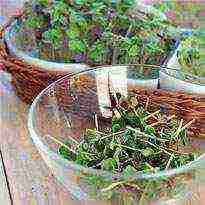 Step four |
When the seedlings reach about 4-5 centimeters in size, you can start harvesting. And the containers that have become empty can be used for a new sowing. |
How to water aloe at home
If experienced growers know well what conditions are needed for aloe, then a beginner may find the growing technology and ensuring proper care for it rather complicated. For example, it can be helpful to learn how to water aloe at home.
Video - Tips for growing in a hydrogel
